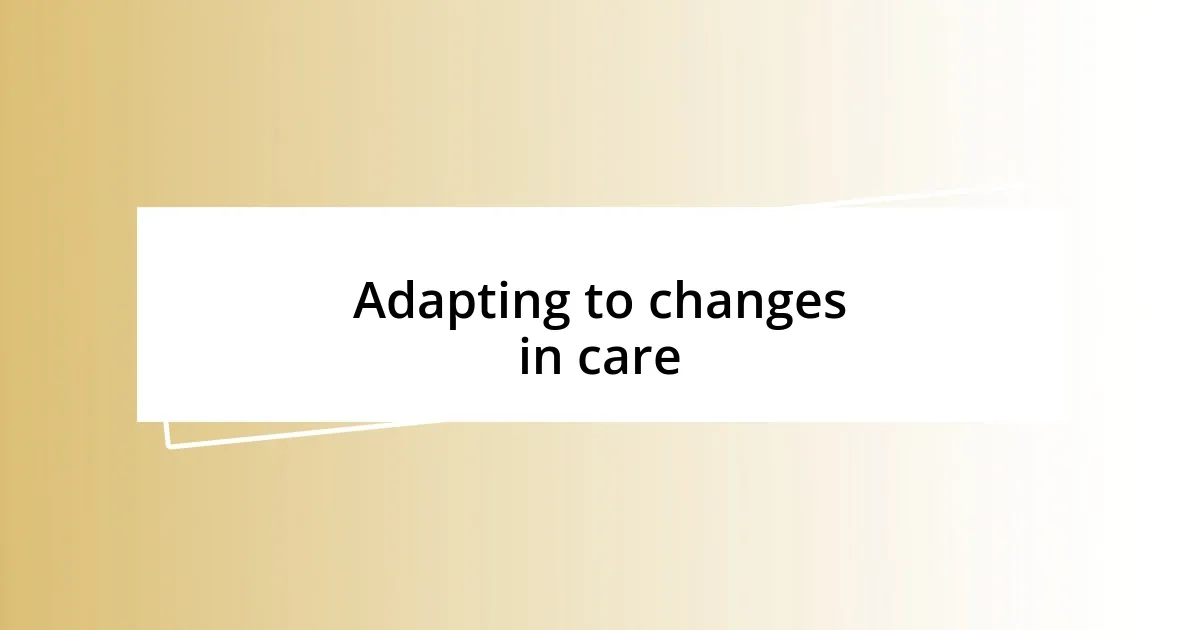Key takeaways:
- Virtual healthcare provides convenience and accessibility, allowing patients to consult specialists from anywhere, enhancing comfort during discussions.
- Choosing user-friendly and secure technology tools is crucial for a positive virtual healthcare experience.
- Effective communication and follow-up practices strengthen doctor-patient relationships and ensure clarity in health management.
- Organizational strategies, like using digital calendars and tracking health metrics, empower patients to take control of their healthcare journey.

Understanding virtual healthcare benefits
One of the standout benefits of virtual healthcare for me has been the convenience it offers. I remember a time when I was juggling a hectic schedule, and the thought of driving to a clinic was exhausting. With a few clicks, I was able to consult a doctor right from my living room, saving both time and energy. Isn’t it amazing how technology can bring healthcare directly to us?
Another aspect I appreciate is the accessibility it provides. For instance, I’ve seen friends struggle to find appropriate specialists in their area. With virtual healthcare, they could connect with top professionals anywhere in the country or even the world. This opens up a whole new realm of possibilities for seeking expertise and personalized care that may not have been available otherwise.
I can’t help but reflect on the enhanced comfort of discussing health concerns from home. There’s something about being in a familiar environment that can ease anxiety, making it easier to be open and honest. Have you ever felt more comfortable discussing sensitive issues while at home? From my experience, this level of comfort can lead to more productive conversations and a stronger doctor-patient relationship.

Choosing the right technology tools
Choosing the right technology tools for virtual healthcare is crucial for a seamless experience. I recall when I first tried telehealth and was bombarded by options; my head spun with different platforms and their features. It became clear that not all tools are created equal. I found that the right video conferencing software could either make or break my consultation, directly impacting my experience and comfort level.
As I explored various tools, I realized the importance of user-friendliness. The first app I tried was so complicated that I almost gave up before my appointment even started! In contrast, a straightforward interface cut down on anxiety and made connecting with healthcare professionals feel like a breeze. Have you ever been frustrated by technology? The right tool can alleviate those frustrations and ultimately enhance your healthcare journey.
Security was another major consideration for me. During one appointment, I found comfort in knowing that the platform employed robust encryption, ensuring my discussions remained confidential. Protecting my privacy has become a non-negotiable. This experience taught me that while functionality is essential, prioritizing security is just as vital in building trust in virtual healthcare.
| Technology Tool | Pros |
|---|---|
| Video Conferencing Software | Easy to use for patients; allows face-to-face interaction |
| Patient Portals | Centralized access to medical records and communication |
| Mobile Health Apps | Convenient tracking of health metrics; enhances engagement |
| Secure Messaging Platforms | Confidential communication; promotes quick responses |

Setting up a conducive environment
Creating a conducive environment for virtual healthcare is paramount. I always ensure that my space is quiet and free from distractions. Once, during an important consultation, a loud noise from outside made it difficult for me to concentrate. It was a reminder of how essential the right environment is for effective communication with my healthcare provider. The sense of calm that comes from a peaceful setting can make all the difference in clarity and comfort during these appointments.
To enhance your virtual healthcare experience, consider these tips for setting up your environment:
- Choose a quiet location: Find a space where you won’t be interrupted.
- Minimize distractions: Turn off notifications on your devices and inform household members of your appointment.
- Ensure proper lighting: Natural light works well, but a bright lamp can also make you more visible to your provider.
- Create a comfortable seating arrangement: Make sure you have a chair that supports your back and is positioned at an engaging angle.
- Have necessary items within reach: Keep water, pads for notes, and any documents needed for your appointment close by for easy access.
By thoughtfully curating your environment, you set the stage for a more productive and relaxed healthcare experience.

Effective communication with healthcare providers
Effective communication has been a game changer for me in virtual healthcare. One time, I felt a twinge of anxiety when discussing my symptoms. But when my provider took the time to ask open-ended questions, it opened the floodgates for me to share more. I discovered that fostering a two-way conversation during my appointments not only helped me articulate my concerns better but also built a rapport that made me feel heard and valued. Have you ever felt that sense of relief when someone truly listens?
I also learned that being upfront about my preferences can significantly enhance my interactions. For example, I once told my doctor that I preferred clear, straightforward language rather than medical jargon, which made a world of difference. It’s amazing how a little honesty can bridge the gap between a provider’s expertise and a patient’s understanding. This experience taught me that effective communication is not just about conveying information; it’s about creating a shared space for meaningful dialogue.
Moreover, I find that following up after appointments ensures that nothing slips through the cracks. After a recent visit, I sent a quick message through the patient portal to clarify some instructions. The prompt response was reassuring and highlighted the importance of leaving no stone unturned in our communication. Have you ever had a nagging question after an appointment? Taking that extra step for clarity makes all the difference in my healthcare journey, reinforcing the notion that communication is a vital part of my wellbeing.

Managing appointments and follow-ups
Managing appointments in the virtual healthcare landscape has its unique set of challenges, but I’ve found that being organized is key. One strategy that works wonders for me is using a digital calendar that can send reminders well in advance. Have you ever missed an appointment simply because you lost track of time? I certainly did, and it was frustrating. Since I started syncing my healthcare appointments with my phone’s calendar, it has been a game changer.
Follow-ups can often feel overwhelming, especially when there are multiple healthcare providers involved. I learned the hard way how crucial it is to keep a checklist after each visit. For instance, after a recent consultation, I noted down follow-up tests I needed and questions that popped into my head. This not only ensures I don’t overlook important details but also empowers me to take charge of my health. I often remind myself, if it’s on paper, it’s less likely to slip my mind.
Additionally, I’ve found value in establishing a routine for checking in with my provider. After one of my appointments, I made it a point to send a brief message via the healthcare portal a few days later. I wanted to express my gratitude for the insights and ask if any follow-up resources were available. The response I got showcased how such small interactions could foster a deeper connection, reminding me that it’s okay to seek ongoing support. Have you reached out like this after an appointment? You might be pleasantly surprised by the rapport you build!

Tracking health metrics and progress
Tracking health metrics has become a vital part of my virtual healthcare experience. Utilizing apps to log my daily activities, such as steps taken and hours slept, has provided me with a clear picture of my overall health. One time, when I noticed a dip in my energy levels, I looked back at my sleep data and realized I’d been averaging less than six hours a night. It was eye-opening! Have you ever had a moment where data illuminated something you hadn’t noticed before?
What truly enhances my tracking experience is setting specific, measurable goals. For instance, after discussing my blood pressure readings with my doctor, I decided to aim for a target reduction. I used a simple spreadsheet to monitor my weekly readings, and witnessing gradual improvement was incredibly motivating. There’s something empowering about making my health a priority—like I’m actively participating in my journey rather than just being a passive observer. How does taking control of your metrics fuel your motivation?
Moreover, I’ve found that sharing these metrics with my healthcare providers boosts accountability. When I bring my tracking logs to appointments, it sparks more in-depth discussions about my progress and adjustments needed in my care plan. Just the other week, I shared my dietary tracking with my nutritionist. This led to personalized suggestions that made meal planning more enjoyable and tailored to my needs. It’s amazing how having this data not only aids in my journey but also enriches the dialogue with my provider. Have you ever experienced the power of numbers in your health conversations? It can truly reshape the way you see your wellness.

Adapting to changes in care
I’ve had to adjust my mindset significantly when it comes to adapting to changes in care. Transitioning from in-person visits to virtual check-ins felt disorienting at first. I remember the first time I logged onto a video consultation—my nerves were palpable, almost palpable enough that I felt the awkwardness through the screen. But I quickly learned to embrace the technology. Have you noticed how being in a familiar environment can help you relax during these virtual interactions? I found that sitting in my cozy chair, surrounded by comforts, made it easier to engage openly with my provider.
Communication styles also shifted as I adapted to virtual healthcare. I had to embrace the art of being concise yet comprehensive. During one particularly impactful appointment, I prepared a list of my concerns and symptoms beforehand, which proved invaluable. I remember feeling empowered as I shared my experience, realizing that my input really shaped our discussion. Have you tried outlining your thoughts before a healthcare visit? It can truly enhance the quality of your interactions.
As healthcare evolves, I’ve also recognized the importance of being flexible with my care plans. Changes in protocols or the introduction of new technology can be daunting, but they often open doors to innovative approaches. When my provider suggested a new app for medication reminders, I was skeptical at first. Yet, after giving it a try, I found that it simplified my routine and reduced the stress of remembering doses. Have you ever hesitated to try something new, only to realize it was just what you needed? Embracing adaptability not only benefits my health but also strengthens my resilience in this ever-evolving virtual landscape.














